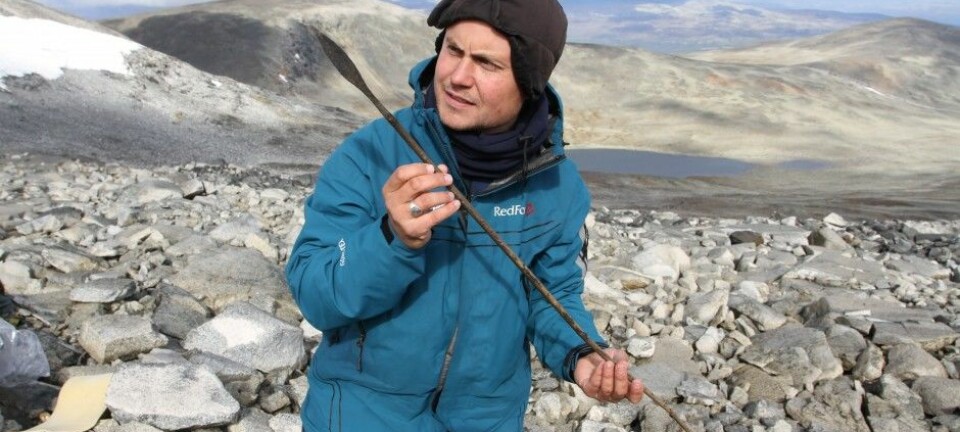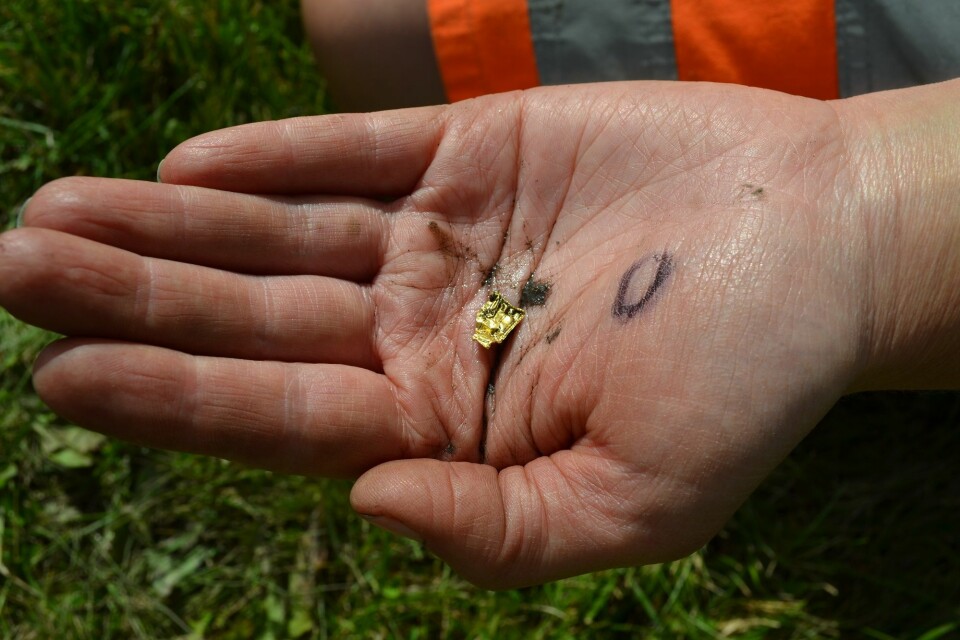
The mystery from pre-Viking days: Only the most powerful had these little pieces of gold
Was it a gold ticket to important meetings? Or proof that you were related to the Gods? A new gold foil figure was recently found in Vestfold.
Sverre Næsheim wasn’t out for a regular walk. He had brought his metal detector, and he was walking with it in an area of historic interest.
- I read up on the history of this place when I moved here four years ago, he said to NRK, which first reported the story.
A trading route used to pass through the place where we today find Hovland farm in Tjølling, Larvik. Sverre figured he might find something of interest there – and he did.
A tiny piece of gold, roughly the size of a fingernail, and with motifs of what appears to be a man and a woman, made the metal detector sound its beep.
Well, for a gold foil figure, as they are called, this particular piece was on the larger size, measuring 1,2 cm x 1,6 cm.
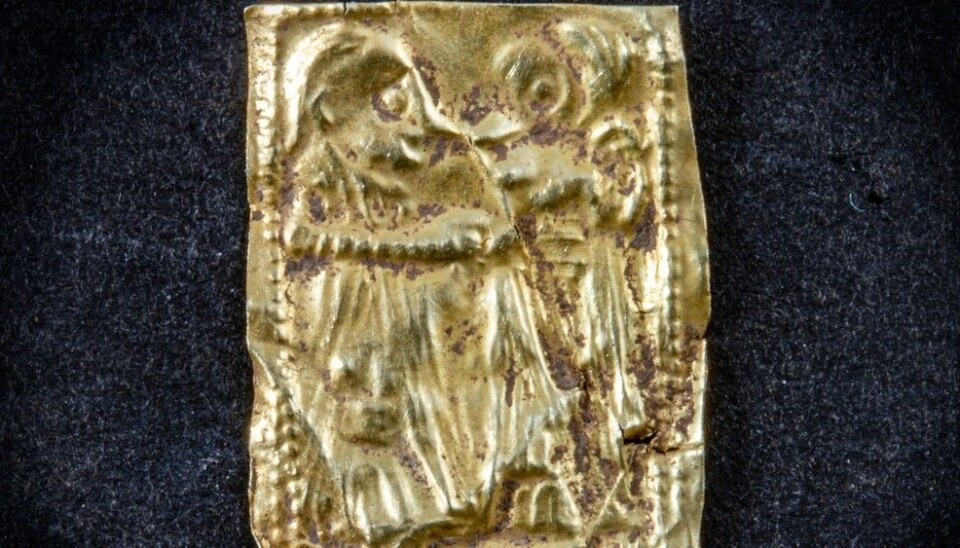
A tiny huge finding
“Even if such a gold foil figure is tiny, this is a huge finding”, says archaeologist Ingar Mørkestøl Gundersen from the Museum of Cultural History.
A few years ago he lead an excavation where two such gold foil figures were found.
“It’s one the greatest things I’ve experienced as an archaeologist”, he says.
But what are they? These tiny thin little pieces of gold. What were they used for?
The researchers don’t really know.
Basically, gold foil figures are a mystery.
For people in power
Researchers do feel pretty certain however, that only people with a lot of power used these gold pieces.
The two gold foil figures that Gundersen participated in finding, were located at Åker farm in Hamar. This used to be an important place for chiefs around 1500 years ago. Powerful people are assumed to have met in this spot. Perhaps the gold foil figures played a part in these meetings? Perhaps they were tickets to important meetings?
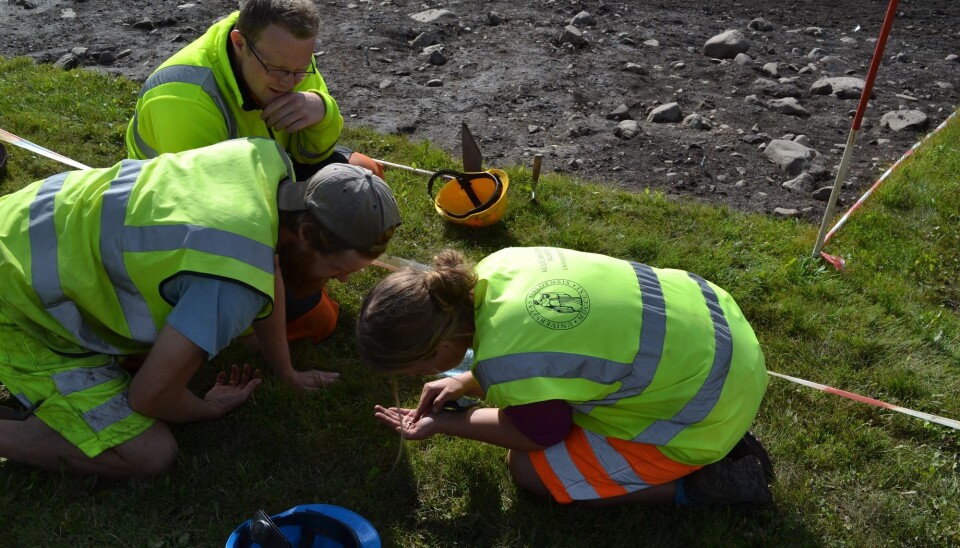
Evidence in the age of petty kingdoms?
The article from NRK, about the recent finding, leads the story with the heading “new viking findings”. This is strictly speaking not quite correct.
The Viking Age started around year 800. Gold foil figures were mostly in use before the Vikings, during the Merovingian age, or “the age of petty kingdoms” as it is sometimes called.
“This is classic media – everything that is not called medieval is called the Viking Age”, says Gundersen.
“People are familiar with the Vikings. But the gold foil figures are mainly associated with the period before the Vikings, the Merovingian age. But then again, the Viking Age is just a continuation of the Merovingian Age, so perhaps it’s not such a big deal. The foundation for the Viking Age, ideologically, religiously and militarily, stems from the Merovingian age.”
Norway became a country with one king around 865, under Harald Hårfagre. During the age of petty kingdoms however, there would have been an abundance of powerful people, ruling their little part of what was to become Norway.
One theory is that these rulers used gold foil figures to signal that they were special, or to claim that they were related to the Gods in Norse mythology.
Related to the Gods?
So why is this a theory? Well, upon closer examination, researchers found that the small pieces of gold were decorated with figures.
At first they believed they were only men – which gave the little bits the name “gullgubbe”, which roughly translates to “old golden man”. This word is still used today – however, researchers have since discovered that also women appear on the gold bits. Though some of them only show one man, often the image is a man and a woman.
Some reseachers believe these are to represent figures from Norse Mythology, the religion of the day.
Some speculate that what we see is a wedding, and that these little gold pieces in the age of petty kingdoms signalled something about geneaology. That the image somehow signalled that a person was related to the Gods, and thus had a God given right to rule.
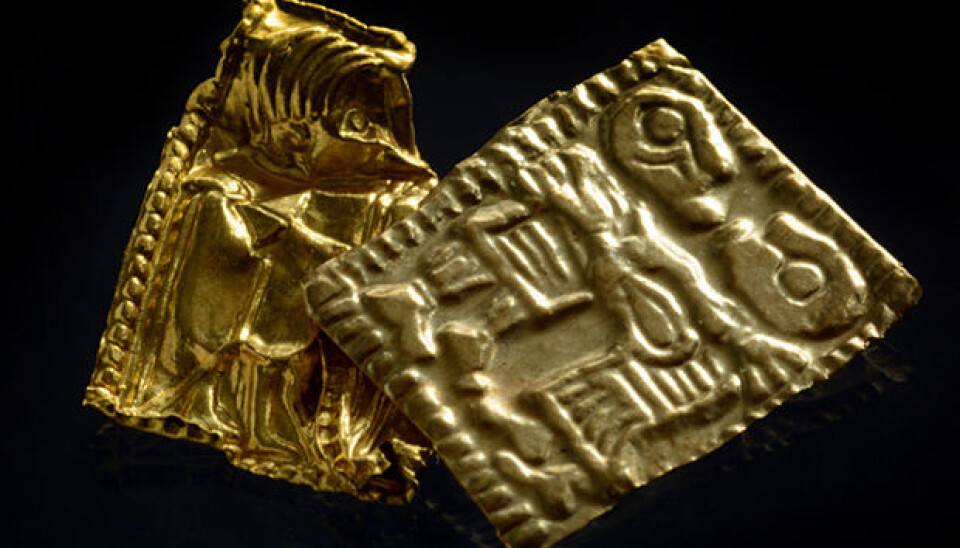
Found in places of importance
Gold foil figures have been found in many places in Norway, usually in locations that were considered important before the onset of the Viking Age.
They have been found in places where people would have met to make sacrifices to the gods, and in places where people of power met.
“When you find a gold foil figure you can be pretty sure that you are onto the people who ruled what was to become Norway around 1500 years ago”, says archaeologist Gundersen.
To date, gold foil figures have only been found in Norway, Sweden and Denmark. In Norway, there have been less than a hundred findings. In Denmark however there have been plenty more. In one famous site on the island of Bornholm, archaeologists found more than 2500 pieces.
The gold foil figures found in Denmark have a higher variety of motifs, which includes pigs, deer and bears.
A mysterious age
We don’t know much about the age of petty kingdoms in Norway. But Gundersen believes it must have been a special time to be alive. And we can outline some central features.
“I always say that the Viking Age is overrated. The really big changes happen in 500-600 AD”, says the archaeologist.
Among other things, people would have experienced a climate crisis opposite to the one we are facing today. The Fimbul winter, meaning the great winter, was long considered a myth. Researchers however now believe it took place between 536 AD to the 660s AD. Due to two volcanoes erupting, there were no real summers during this period. Some believe that around half the people who lived in Norway and Sweden died.
Gundersen is currently researching the Fimbul winter for his phd-thesis. He is however skeptical of the estimate of the number of deaths this crisis caused.
“I believe the Fimbul winter was a watershed, but perhaps not as apocalyptic as some suggest”, he says.
Changes in power structures had begun before the long winter. New dynasties that in various ways profited from the crisis emerged. These were often a mix of old and new rulers. Enormous burial mounds were built during this period. These overshadow all such burial mounds built before or after.
“There was probably a lot of war and fighting”, says Gundersen.
“Warrior aristocracies stood against older ruling classes whose power had been based on ownership of land.”
People wanted more power, and they wanted to take power from the old rulers. Being able to argue that you were related to the Gods might have been a good card to play in this struggle.
“And maybe this is where the gold foil figures came into play?”, Gundersen speculates.
An unsolvable mystery?
In a blog-post from 2017 (in Norwegian), Jessica Leigh McGraw from the Museum of Cultural History, lists a few other theories as well.
In terms of acting as a ticket to special meetings, the gold foil figures might have served to assure others of identity and belonging – so they could know which kingdom you belonged to.
Some of the gold foil figures seem to emphasize motives related to fertility. Perhaps they were messages of courtship?
Some have suggested that various hand gestures in the images could express something as legally binding, or that perhaps the gold foil figures were a sort of temple money or offerings.
“All these interpretations share a basic assumption – that the gold foil figures are objects with no clear practical function”, writes McGraw.
We interpret them through current ideological and political theories, and they can therefore be understood in multiple ways.
“But these little images of gold contain a symbolism that we cannot quite capture”, she writes. “And that will likely remain a mystery into the future”.
———
Read the Norwegian version of this article (written for a younger audience on ung.forskning.no)









